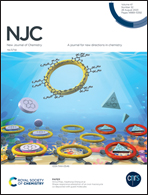Efficient photocatalytic performance and the mechanism of copper(i) metal–organic framework nanosheets†
Abstract
Two dimensional metal–organic framework nanosheets usually have rich active sites and can enhance the photocatalytic performance. Herein, the Cu(I) metal–organic framework, [Cu2·L·Cl2]n (L = 4,4′-bipyridine) (1), and its nanosheets with a lattice thickness of about 5 nm were synthesized by ultrasonic waves. Under visible light irradiation, the nanosheets can rapidly photocatalytically degrade methylene blue (MB) and methyl orange (MO), and their performance is the best under acidic conditions, which can reach 2.00 mg L−1 h−1 and 6.25 mg L−1 h−1, respectively. They are 1.25 and 3.76 times of P25, respectively. In situ electron paramagnetic resonance (EPR), density functional theory (DFT) calculations and electrospray ionization mass spectroscopy (ESI-MS) showed that Cu(I) in the nanosheets was oxidized to Cu(II) during the photocatalytic degradation of organic pollutants, and functional groups with high electronegativity in MB and MO were first broken by the oxidation of ˙OH.



 Please wait while we load your content...
Please wait while we load your content...